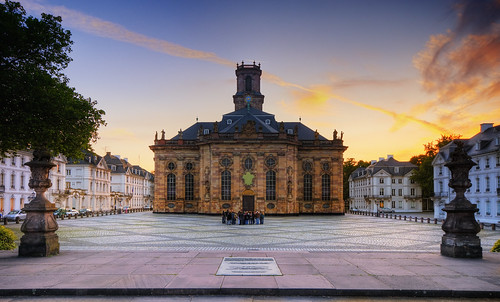Abends am Ludwigsplatz

Image by Wolfgang Staudt
Klick here for a large view!
Ludwigskirche in Old Saarbrücken, Germany, is a Protestant baroque style church. It is the symbol of the city and is considered to be one of the most important Protestant churches in Germany, along with the Dresden Frauenkirche and the St. Michaelis Church, Hamburg ("Michel").
Ludwigskirche and the surrounding Ludwigsplatz (Ludwig’s Square) were designed as a "complete work of art", in the sense of a baroque place royale, by Friedrich Joachim Stengel on the commission of Prince Wilhelm Heinrich von Nassau-Saarbrücken. Construction was begun in 1762. After the death of Wilhelm Heinrich in 1768, work on it was stopped due to lack of funds. The church was finally completed in 1775 by his son, Ludwig von Nassau-Saarbrücken, and it was also named after him. The consecration of the church took place on August 25, 1775, with a church service and a cantata composed especially for the occasion.
In 1885-1887 and in 1906-1911, the church underwent restoration. During the Second World War, Ludwigskirche was severely damaged. After a bombing on October 5, 1944, only the surrounding walls remained. Rebuilding began in 1949, however it has still not been completed. A fundamental reason for this long delay was the fierce dispute, which lasted from the 1950s into the 1970s, about whether the baroque interior, which had been completely lost, should also be reconstructed. At first, it had been agreed to restore the exterior, with a modern interior, but this plan was finally abandoned. At this time (2007), the "Fürstenstuhl" (i.e., the royal seating in the gallery across from the organ) in the interior and some of the balustrade figures on the outside are still lacking.
The ground plan is shaped somewhat like a Greek cross; the arms are 38.5 m and 34.2 m long and are each 17 m wide. There are niches on the outside which contain statues of the four Evangelists by Francuß Bingh. The stone balustrades were decorated with 28 figures, also by Bingh, depicting the apostles, prophets and other Biblical people.
The interior of the church is decorated with ornamental stucco (cartouches, rocaille). Each of the four arms of the cross has a gallery supported by two to four caryatids. The floor is made of sandstone.
Special features of the interior are the arrangement of the church by and large along the width of the church, on the one hand, and the placement of the altar, pulpit and organ over each other (a so-called "pulpit-altar"), on the other hand. The arrangement with the altar, pulpit and organ is rather unusual for a Lutheran church, but it had already been used by Stengel in some of his earlier buildings.
Stengel designed not only the overall plan of the church and the surrounding palaces, from the handles for the doors to the overall grounds, but he also fit the church and the square into the two main viewing axes of the city’s layout. One of these axes, from the "Alten Kirche" (Old Church) in the city district of St. Johann, through the Wilhelm-Heinrich-Straße of today and the main entrance, up to the altar, is still visible today. The other axis points over the exit, which faces the Saarland state chancellery today, toward the former royal summer residences on Ludwigsberg, the so-called Ludwigspark.
The restoration of the original white paint on the exterior is still currently being disputed. This had existed until 1945 and it would also be important for fitting the church into the square, but it has become quite a strange idea to many local residents in the past decades.
From Wikipedia, the free encyclopedia
Tags:Cool, Design, ideas, images, interior, modern


0 comments:
Post a Comment